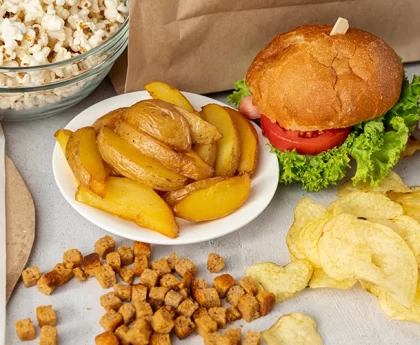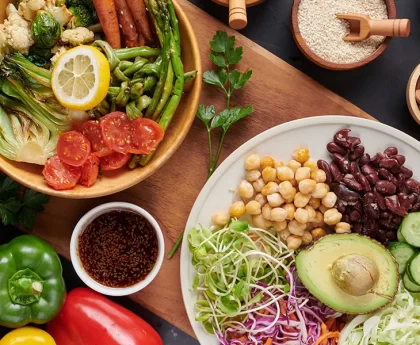Doughnut: is a type of fried or baked pastry confectionery that is typically ring-shaped and made from sweetened dough. The dough is usually leavened with yeast or baking powder, which gives the doughnut its characteristic light and airy texture. After being shaped into a ring, the dough is either deep-fried in oil or baked in an oven until it becomes golden brown and crispy on the outside, while remaining soft and tender on the inside.
Doughnuts can vary widely in terms of flavor and toppings. They are often coated with a glaze or icing made from sugar, and may also be dusted with powdered sugar or sprinkled with various toppings such as sprinkles, chopped nuts, or chocolate chips. Some doughnuts are filled with sweet fillings like jelly, custard, or cream.
Doughnuts are a popular treat in many cultures around the world and are often enjoyed as a breakfast food or as a dessert. They come in a wide variety of flavors and styles, including the classic glazed doughnut, chocolate-covered doughnuts, and those with creative fillings and toppings.
National Doughnut Day (7th June)
Types of Doughnut
Doughnuts come in a wide variety of types, each with its own unique flavors, shapes, and toppings.
Here are some common types of doughnuts:
- Ring Doughnut: This is the classic doughnut shape with a hole in the center. It’s often coated with a glaze or icing, and it can come in various flavors such as vanilla, chocolate, or maple.
- Filled Doughnut: These doughnuts are typically round and filled with a sweet filling, such as fruit jam, custard, chocolate, or cream. They may be dusted with powdered sugar or glazed on top.
- Long John: Long John doughnuts are rectangular in shape and are often filled or topped with various flavored icings or glazes.
- Jelly Doughnut: Also known as a “jelly-filled” doughnut, these are typically round and filled with fruit jam or jelly. They are often dusted with powdered sugar or glazed.
- Bismark: Bismark doughnuts are similar to jelly doughnuts but are usually square or rectangular in shape.
- Cake Doughnut: Cake doughnuts are denser and have a cake-like texture compared to yeast-raised doughnuts. They can be plain or flavored and are often dusted with powdered sugar or coated in glaze.
- Old-Fashioned Doughnut: These doughnuts have a distinctive, irregular shape and a slightly crunchy exterior. They are typically made with a cake-like batter.
- Cruller: Crullers are twisted and have a delicate, flaky texture. They are often coated with a sweet glaze or icing.
- French Cruller: A type of cruller that is light and airy, often made with choux pastry dough and topped with a honey glaze.
- Bear Claw: Bear claws are irregularly shaped and often filled with almond paste or cinnamon filling. They are then topped with sliced almonds and icing.
- Fritter: Fritters are irregularly shaped and may contain chunks of fruit, such as apples or bananas, and spices. They are typically fried and coated in a glaze.
- Maple Bar: Maple bars are rectangular in shape and topped with a maple-flavored icing.
- Glazed Twist: These are twisted doughnuts that are coated with a sweet glaze.
- Cronut: A cronut is a hybrid pastry that combines elements of a croissant and a doughnut. It is flaky and layered like a croissant but fried like a doughnut and often filled or topped with various flavors.
- Gourmet Doughnuts: Many bakeries and specialty shops offer gourmet doughnuts with unique flavor combinations and artisanal toppings, such as bacon, caramel, or exotic fruits.
These are just a few examples of the many types of doughnuts you can find, and creative variations are constantly emerging as bakers experiment with new ingredients and flavors.

Benefits of Doughnut
While doughnuts are a delicious treat, they are not typically considered a health food. However, in moderation and as an occasional indulgence,
There can be some enjoyment and benefits associated with consuming doughnuts:
- Taste and Enjoyment: Doughnuts are known for their sweet and satisfying taste. Enjoying a doughnut can be a pleasurable experience and a simple way to indulge in a sweet treat.
- Social Enjoyment: Doughnuts are often shared with friends and family, making them a part of social gatherings and celebrations, which can contribute to positive social experiences.
- Comfort Food: For some people, doughnuts serve as a comfort food that can provide emotional comfort and satisfaction in times of stress or sadness.
- Source of Energy: Doughnuts are calorie-dense and contain sugars and carbohydrates, which can provide a quick source of energy when needed.
- Cultural Significance: Doughnuts hold cultural significance in many places and are associated with traditions and celebrations. For example, they are a common breakfast item in the United States.
- Variety and Creativity: Doughnuts come in a wide variety of flavors and toppings, allowing for creativity and experimentation in the culinary world. This diversity can be exciting for both consumers and bakers.
It’s important to note that while there may be some enjoyment associated with eating doughnuts, they are not a nutritious food choice and should be consumed in moderation. Doughnuts are typically high in sugar, unhealthy fats, and calories, which can contribute to weight gain and other health issues when consumed excessively. For a balanced diet, it’s best to prioritize healthier food choices and reserve doughnuts as an occasional treat rather than a regular part of your diet.
The Taste of a Doughnut To You Can Try
The taste of a doughnut can vary depending on its flavor, ingredients, and how it’s prepared. However,
Here’s a general description of the taste of a typical, classic doughnut:
- Sweetness: Doughnuts are known for their sweet taste. They are typically made with sugar in the dough, and many varieties are coated with sugary glazes or icings. This sweetness is one of the defining characteristics of a doughnut.
- Richness: Doughnuts often contain fats like butter or oil, which contribute to a rich and slightly savory undertone in the flavor.
- Doughy and Tender: The interior of a well-made doughnut is soft, tender, and slightly chewy. It should have a pleasant, doughy texture.
- Flavor Variations: The specific flavor of a doughnut can vary greatly depending on its type. For example, a classic glazed doughnut has a vanilla and sugar flavor, while a chocolate doughnut will have a cocoa flavor. Filled doughnuts, like jelly-filled or cream-filled ones, will have the added flavor of their fillings.
- Toppings: The taste can also be influenced by any toppings or fillings added to the doughnut. For instance, a doughnut with a fruity filling will have a fruity element to its taste, while a doughnut topped with nuts will have a nutty crunch and flavor.
Overall, the taste of a doughnut is a delightful combination of sweetness, richness, and the specific flavors added through ingredients like vanilla, cocoa, or fillings. Doughnuts are enjoyed for their comforting and satisfying taste, making them a popular treat around the world.
Is it good to eat doughnut?
Eating a doughnut is not inherently good or bad; it depends on various factors, including your overall diet, health goals, and how frequently you consume them.
Here are some considerations:
- Moderation: Doughnuts are typically high in sugar, unhealthy fats, and calories. Consuming them in moderation, as an occasional treat, is generally fine for most people. It’s important not to make them a regular part of your daily diet.
- Balanced Diet: To maintain good health, it’s essential to have a balanced diet that includes a variety of nutrient-rich foods like fruits, vegetables, lean proteins, and whole grains. Doughnuts should be seen as an occasional indulgence rather than a staple food.
- Portion Size: Be mindful of portion sizes. Some doughnuts can be quite large and calorie-dense. Consider sharing or opting for smaller-sized doughnuts if available.
- Nutritional Choices: If you have dietary restrictions or health concerns, consider alternatives like baked doughnuts or those made with healthier ingredients, such as whole wheat flour or reduced sugar content.
- Frequency: Eating doughnuts too frequently can contribute to weight gain and other health issues, particularly if they are replacing more nutritious food choices.
- Health Goals: Consider your specific health and fitness goals. If you’re trying to lose weight, manage blood sugar, or improve your overall health, consuming doughnuts regularly may not align with those objectives.
- Individual Tolerance: People’s tolerance for indulgent foods varies. Some individuals may be able to enjoy doughnuts without adverse effects on their health, while others may need to be more cautious due to factors like metabolism and underlying health conditions.
In summary, enjoying a doughnut from time to time as a treat is generally okay for most people. However, it’s important to maintain a balanced diet and be mindful of how often and how much you consume. If you have specific dietary concerns or health conditions, it’s a good idea to consult with a healthcare professional or registered dietitian for personalized guidance on your diet.
What is the most popular doughnut in the world?
The popularity of doughnut varieties can vary by region and personal preferences, so it’s challenging to pinpoint a single “most popular” doughnut in the world. However, some doughnut types and flavors have gained widespread popularity and recognition globally.
Here are a few:
- Glazed Doughnut: The classic glazed doughnut, with its simple yet irresistible combination of sweet glaze and soft dough, is a favorite in many countries. It’s a staple in many doughnut shops.
- Chocolate-Frosted Doughnut: Doughnuts covered in a rich chocolate glaze or icing are also highly popular worldwide. They often have a chocolate cake or yeast-raised base.
- Jelly-Filled Doughnut: Known by various names (e.g., jelly doughnut, jam doughnut), this type is a favorite in many places. It features a soft, round doughnut filled with fruit jam or jelly and often powdered sugar or glaze on top.
- Cream-Filled Doughnut: Cream-filled doughnuts, often filled with vanilla or chocolate cream, are enjoyed in many countries and can have various toppings and decorations.
- Maple Bar: Maple bars, rectangular doughnuts with a maple-flavored icing, are particularly popular in North America.
- Cinnamon Sugar Doughnut: Doughnuts coated in a mixture of cinnamon and sugar are beloved for their warm and comforting flavor.
- Custard-Filled Doughnut: These doughnuts are filled with creamy custard and can be found in many parts of the world.
It’s worth noting that regional preferences and innovations can result in a wide variety of unique and beloved doughnut styles. Additionally, gourmet and specialty doughnut shops have gained popularity in recent years, offering an array of inventive and artisanal doughnuts with unconventional flavors and toppings.
Ultimately, the “most popular” doughnut can vary greatly from person to person and place to place, but the ones mentioned above tend to have broad appeal and recognition.

How to Make Delicious Doughnuts in Home!
Making delicious doughnuts at home can be a fun and rewarding baking project. Here’s a basic recipe for making classic homemade doughnuts:
Ingredients:
- For the doughnuts:
– 2 ¼ teaspoons active dry yeast
– 2/3 cup warm milk (110°F or 43°C)
– 1/4 cup granulated sugar
– 2 tablespoons unsalted butter, melted
– 1 teaspoon salt
– 2 large eggs
– 3 1/2 cups all-purpose flour (approximately)
– Vegetable oil (for frying) - For the glaze (optional):
– 2 cups powdered sugar
– 1/4 cup milk
– 1 teaspoon vanilla extract
Instructions:
- Activate the Yeast:
– In a small bowl, combine the warm milk and yeast. Let it sit for about 5-10 minutes until it becomes frothy and foamy. This indicates that the yeast is active. - Mix the Dough:
– In a large mixing bowl, combine the sugar, melted butter, salt, and eggs. Mix well.
– Add the activated yeast mixture to the bowl and stir to combine.
– Gradually add the flour, about 1/2 cup at a time, stirring continuously, until you have a soft and slightly sticky dough. You may not need to use all of the flour; it depends on the humidity and other factors. - Knead the Dough:
– Turn the dough out onto a floured surface and knead it for about 5-7 minutes until it becomes smooth and elastic. If the dough is too sticky, you can add a little more flour as needed. - First Rise:
– Place the dough in a greased bowl, cover it with a clean kitchen towel or plastic wrap, and let it rise in a warm, draft-free place for about 1-2 hours or until it has doubled in size. - Shape and Cut:
– Once the dough has risen, punch it down to release any air bubbles.
– Roll out the dough on a floured surface to about 1/2-inch thickness.
– Use a doughnut cutter or a round cookie cutter to cut out doughnuts. If you don’t have a cutter, you can use a glass for the outer circle and a smaller one for the hole in the center. - Second Rise:
– Place the cut doughnuts on a baking sheet lined with parchment paper. Cover them with a kitchen towel and let them rise for another 30 minutes to an hour. - Fry the Doughnuts:
– Heat vegetable oil in a deep fryer or a heavy-bottomed pot to 350-375°F (175-190°C).
– Carefully place the doughnuts in the hot oil, a few at a time, and fry for about 1-2 minutes per side or until they are golden brown.
– Use a slotted spoon to remove the doughnuts from the oil and place them on paper towels to drain any excess oil. - Glaze the Doughnuts (Optional):
– In a mixing bowl, whisk together the powdered sugar, milk, and vanilla extract until you have a smooth glaze.
– Dip each doughnut into the glaze, allowing any excess to drip off, and place them on a wire rack to set. - Enjoy:
– Allow the glaze to set for a few minutes, and then your homemade doughnuts are ready to enjoy!
Feel free to get creative with toppings and fillings if you like. You can use different glazes, sprinkles, or fill the doughnuts with jam, cream, or other sweet fillings. Homemade doughnuts are best when served fresh and warm.





